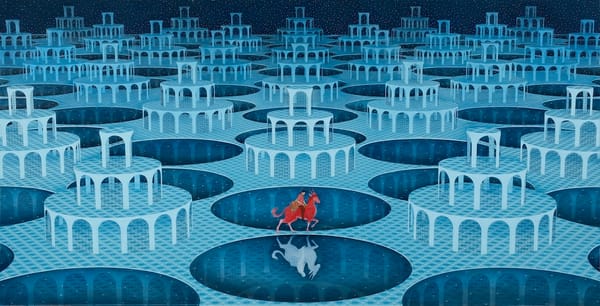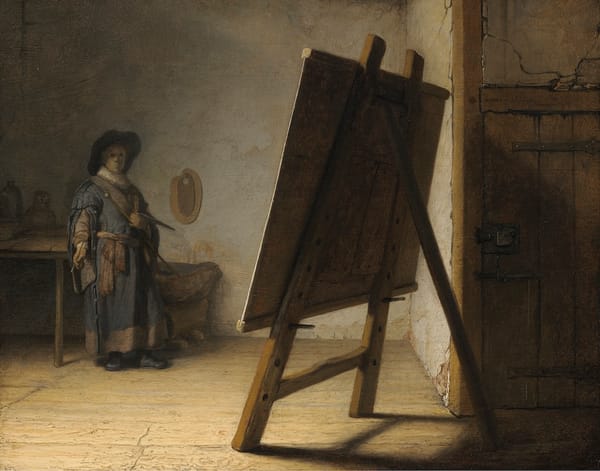Life Beyond the Canvas: The Lesser-Known Passions of Great Artists
Beyond their iconic masterpieces, history's great artists harbored lesser-known passions—from science and music to spirituality and nature. These pursuits profoundly influenced their creative output, revealing the multifaceted lives that shaped their extraordinary art.

When we think of history’s great artists, it’s easy to reduce their lives to their most famous works. We picture Vincent van Gogh’s swirling skies, Leonardo da Vinci’s enigmatic portraits, or Yayoi Kusama’s vibrant dots, and we assume that their lives were consumed entirely by their art. Yet, behind the canvases and sculptures, many of these artists harbored other passions—some of which had a profound impact on their creative output. This article explores the lesser-known interests of some of history’s most iconic artists, offering a fuller picture of the multifaceted lives they led.
1. Leonardo da Vinci: The Renaissance Polymath
Leonardo da Vinci is often hailed as the epitome of the "Renaissance Man," a title he earned not just through his artistic achievements but also through his insatiable curiosity about the natural world. While his masterpieces like The Last Supper and the Mona Lisa are universally celebrated, da Vinci’s lesser-known pursuits in science and engineering reveal the breadth of his genius.
Da Vinci's notebooks are filled with sketches and notes on anatomy, botany, mechanics, and even aeronautics. He dissected human corpses to understand the structure of muscles and bones, creating some of the most detailed anatomical drawings of his time. These studies not only advanced the field of anatomy but also informed his art, allowing him to create more lifelike and accurate depictions of the human form.
In addition to his scientific endeavors, da Vinci was deeply interested in engineering. He designed machines that were centuries ahead of their time, including early concepts for helicopters, tanks, and even a robotic knight. His fascination with the mechanics of movement and structure can be seen in the precision and detail of his art. For Leonardo, art and science were not separate disciplines; they were intertwined, each informing and enriching the other.
2. Wassily Kandinsky: The Painter of Music
Wassily Kandinsky is known as one of the pioneers of abstract art, with works that explode in a symphony of color and form. However, what is less known is that Kandinsky’s abstract style was deeply influenced by his passion for music. He believed that color and form could evoke the same emotional experiences as music, and he often referred to his paintings as "compositions."
Kandinsky’s interest in music was not just a passive hobby; it was central to his artistic philosophy. He was fascinated by the synesthetic experience—the idea that one could "hear" colors or "see" music. This fascination is evident in his writings, particularly in his book Concerning the Spiritual in Art, where he explored the connections between visual art and music.
His painting Composition VII is often described as a visual symphony, with colors and shapes that seem to dance and collide like notes in a piece of music. Kandinsky even likened certain colors to specific musical instruments—yellow to the trumpet, blue to the cello, and so on. This blending of the senses allowed Kandinsky to create a new language of abstract art, one that continues to resonate with viewers on a deeply emotional level.
3. Georgia O'Keeffe: The Artist in Nature
Georgia O’Keeffe is celebrated for her large-scale paintings of flowers, skulls, and New Mexico landscapes, images that have become almost synonymous with American modernism. What many people don’t realize, however, is that O’Keeffe’s art was deeply rooted in her love of nature and the American Southwest, which became her home and sanctuary.
O’Keeffe’s passion for nature extended far beyond the canvas. She was an avid gardener and spent much of her time outdoors, drawing inspiration from the rugged landscape around her. The vast deserts, the clear blue skies, and the unique flora of New Mexico became central themes in her work. Her paintings are not just representations of nature but expressions of her deep connection to the land.
This connection to nature also influenced O’Keeffe’s lifestyle. She lived in a remote area of New Mexico, away from the bustling art scenes of New York and Europe, preferring the solitude and simplicity of the desert. Her home in Abiquiú, which she meticulously renovated, was a reflection of her artistic sensibilities, with clean lines and a strong connection to the surrounding environment. For O’Keeffe, the act of living was as much an art form as her painting, with nature as both her subject and her muse.
4. Salvador Dalí: The Surrealist and His Scientific Obsessions
Salvador Dalí, the flamboyant surrealist known for his melting clocks and dreamlike landscapes, was also deeply fascinated by science and mathematics. While his public persona often overshadowed his intellectual interests, Dalí’s work was heavily influenced by contemporary scientific discoveries, particularly in the fields of quantum physics and molecular biology.
In the 1950s, Dalí became obsessed with the double helix structure of DNA, which had recently been discovered. This fascination is evident in works like Galacidalacidesoxyribonucleicacid (1963), where the structure of DNA is incorporated into a vast, cosmic landscape. Dalí saw the double helix as a symbol of both life and eternity, aligning with his interest in immortality and the infinite. His exploration of these themes led him to create a series of paintings that blended his surrealist style with scientific imagery, merging the fantastical with the empirical.
Dalí’s scientific interests also extended to mathematics, particularly the concept of the fourth dimension and the idea of hypercubes—four-dimensional geometric figures. His painting Crucifixion (Corpus Hypercubus) (1954) is a striking example of this, depicting the crucifixion of Christ on a hypercube, a visualization that seeks to transcend the limitations of three-dimensional space. Through this work, Dalí attempted to represent the divine in a way that was both scientifically advanced and spiritually profound.
Despite his eccentric public persona, which often bordered on the absurd, Dalí’s engagement with science was serious and informed. He believed that modern science, particularly the discoveries in quantum mechanics and molecular biology, provided new ways of understanding reality—ways that could be explored and expressed through art. In this way, Dalí’s lesser-known passion for science significantly influenced his work, pushing the boundaries of surrealism and challenging viewers to see the world through a different lens.
5. Yayoi Kusama: The Polka Dots and Beyond
Yayoi Kusama is renowned for her use of polka dots and her immersive, infinite mirror rooms, which have made her one of the most recognizable contemporary artists. However, Kusama’s art is deeply intertwined with her mental health struggles, which have been a central, if lesser-known, passion in her life.
Kusama has openly discussed how her art is a way to cope with the hallucinations and obsessive thoughts she has experienced since childhood. She often sees the world covered in a pattern of repeating dots, which she describes as a form of obliteration—a way for her to lose herself in the infinite. This compulsion has led to her signature use of polka dots in her work, which she refers to as "infinity nets."
In addition to her visual art, Kusama has pursued other forms of expression, including writing and fashion design, as ways to channel her experiences. Her autobiographical novel, Infinity Net, offers a poignant insight into her life and the mental health issues that have driven her work. Through her various creative outlets, Kusama has built a world where her inner experiences are externalized and shared with the public, turning her personal struggles into universal themes of infinity, self-obliteration, and the interconnectedness of life.
Kusama’s commitment to her art and her mental health is also reflected in her decision to voluntarily live in a psychiatric hospital in Tokyo since the 1970s, where she continues to create. Her life and work are inseparable, each informing the other, and her lesser-known passion for exploring the depths of the mind has resulted in some of the most unique and introspective art of the 20th and 21st centuries.
6. Henri Matisse: The Joy of Life and the Art of Cut-Outs
Henri Matisse is often celebrated for his vibrant paintings and his mastery of color, but later in life, he developed a passion for a different medium—cut-outs. This lesser-known passion emerged when Matisse, confined to a wheelchair after a serious surgery, found it difficult to paint as he once did. Rather than let his physical limitations stifle his creativity, Matisse embraced a new method of art-making that was just as innovative as his earlier work.
Matisse began creating cut-outs by cutting shapes from colored paper, arranging and rearranging them until he achieved the desired composition. These cut-outs, which he referred to as "painting with scissors," allowed him to continue exploring the themes of color and form that had always been central to his work, but in a new and dynamic way. His cut-outs were not just a makeshift solution to his physical challenges; they became a profound and joyful expression of his artistic vision.
One of Matisse’s most famous cut-outs, The Snail (1953), exemplifies this period of his work. The large, abstract composition is made up of simple, brightly colored shapes arranged in a spiral pattern, evoking the form of a snail. The simplicity of the shapes and the vibrancy of the colors convey a sense of joy and freedom, reflecting Matisse’s belief in the power of art to bring happiness.
Matisse’s cut-outs were a testament to his resilience and creativity, showing that even in the face of adversity, he could continue to innovate and express his artistic vision. This late-career passion not only added a new dimension to his oeuvre but also demonstrated that the essence of creativity lies not in the tools we use, but in the spirit with which we approach our work.
7. Vincent van Gogh: The Artist and the Evangelist
Vincent van Gogh is often portrayed as the quintessential tortured artist, whose intense emotional life was mirrored in his vivid, expressive paintings. However, before he fully committed to his art, van Gogh was deeply passionate about religion and aspired to become a pastor like his father. His early attempts to follow this path reveal a lesser-known side of the artist, one that was driven by a profound sense of compassion and a desire to help others.
Van Gogh’s religious zeal led him to work as a missionary in the coal-mining regions of Belgium, where he lived among the miners and shared in their hardships. He was deeply moved by the poverty and suffering he witnessed, and he dedicated himself to serving the community, often giving away his own possessions to those in need. However, his extreme devotion and unorthodox methods eventually led to his dismissal by church authorities, who found him too radical.
This experience of rejection and disillusionment marked a turning point in van Gogh’s life. While his formal religious career ended, his passion for spirituality and his concern for the human condition continued to influence his art. His paintings, such as The Potato Eaters (1885) and Sorrowing Old Man (At Eternity's Gate) (1890), reflect his empathy for the poor and his belief in the dignity of ordinary people. Even as he turned away from organized religion, van Gogh’s art became a means of expressing his deep spiritual convictions.
Van Gogh’s lesser-known passion for religion and social justice offers a more complex understanding of the artist, showing how his early experiences shaped the themes of compassion, suffering, and redemption that permeate his work. His journey from aspiring pastor to groundbreaking artist reveals the ways in which his art was not just a form of self-expression, but also a continuation of his spiritual quest.
Conclusion
The lives of great artists are often seen through the narrow lens of their most famous works, but as these stories show, their passions extended far beyond the canvas. Whether through science, music, nature, or spiritual exploration, these artists found inspiration in a wide range of interests, which in turn enriched and deepened their artistic practice.





